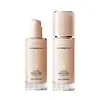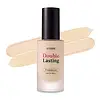What's inside
What's inside
 Key Ingredients
Key Ingredients

 Benefits
Benefits

 Concerns
Concerns

 Ingredients Side-by-side
Ingredients Side-by-side

Water
Skin ConditioningCyclopentasiloxane
EmollientCI 77891
Cosmetic ColorantPhenyl Trimethicone
Skin ConditioningButylene Glycol
HumectantCaprylyl Methicone
Skin ConditioningDimethicone
EmollientIsotridecyl Isononanoate
EmollientCaprylic/Capric Triglyceride
MaskingPentylene Glycol
Skin ConditioningPEG/PPG-18/18 Dimethicone
EmulsifyingDisteardimonium Hectorite
StabilisingSorbitan Sesquioleate
EmulsifyingMagnesium Sulfate
Vp/Hexadecene Copolymer
Polymethylsilsesquioxane
Beeswax
Emulsion StabilisingCI 77492
Cosmetic ColorantBoron Nitride
AbsorbentCetyl PEG/PPG-10/1 Dimethicone
EmulsifyingDimethiconol
EmollientPhenoxyethanol
PreservativeGlycerin
HumectantHydrogenated Lecithin
EmulsifyingTocopheryl Acetate
AntioxidantPropylene Carbonate
SolventTriethoxycaprylylsilane
Polysilicone-11
Alumina
AbrasiveSnail Secretion Filtrate
Skin ConditioningPEG-9 Polydimethylsiloxyethyl Dimethicone
EmulsifyingIsopropyl Titanium Triisostearate
EmollientStearyl Stearate
EmollientCI 77491
Cosmetic ColorantXanthan Gum
EmulsifyingParaffin
PerfumingEthylhexylglycerin
Skin ConditioningParfum
MaskingHydrogenated Castor Oil
EmollientHydrogenated Soybean Oil
EmollientBehenyl Alcohol
EmollientStearic Acid
CleansingCI 77499
Cosmetic ColorantSodium Acetylated Hyaluronate
HumectantSodium Hyaluronate
HumectantSodium Hyaluronate Crosspolymer
HumectantEthylene/Acrylic Acid Copolymer
Emulsion StabilisingHydrolyzed Sodium Hyaluronate
Skin ConditioningMethylparaben
PreservativeCeramide NP
Skin ConditioningPropylparaben
Preservative1,2-Hexanediol
Skin ConditioningBiosaccharide Gum-4
Skin ConditioningAvena Sativa Peptide
Skin ConditioningPropylene Glycol
HumectantOryza Sativa Bran Extract
Skin ConditioningCentella Asiatica Extract
CleansingGinkgo Biloba Leaf Extract
Skin ConditioningPaeonia Suffruticosa Extract
Skin ConditioningWater, Cyclopentasiloxane, CI 77891, Phenyl Trimethicone, Butylene Glycol, Caprylyl Methicone, Dimethicone, Isotridecyl Isononanoate, Caprylic/Capric Triglyceride, Pentylene Glycol, PEG/PPG-18/18 Dimethicone, Disteardimonium Hectorite, Sorbitan Sesquioleate, Magnesium Sulfate, Vp/Hexadecene Copolymer, Polymethylsilsesquioxane, Beeswax, CI 77492, Boron Nitride, Cetyl PEG/PPG-10/1 Dimethicone, Dimethiconol, Phenoxyethanol, Glycerin, Hydrogenated Lecithin, Tocopheryl Acetate, Propylene Carbonate, Triethoxycaprylylsilane, Polysilicone-11, Alumina, Snail Secretion Filtrate, PEG-9 Polydimethylsiloxyethyl Dimethicone, Isopropyl Titanium Triisostearate, Stearyl Stearate, CI 77491, Xanthan Gum, Paraffin, Ethylhexylglycerin, Parfum, Hydrogenated Castor Oil, Hydrogenated Soybean Oil, Behenyl Alcohol, Stearic Acid, CI 77499, Sodium Acetylated Hyaluronate, Sodium Hyaluronate, Sodium Hyaluronate Crosspolymer, Ethylene/Acrylic Acid Copolymer, Hydrolyzed Sodium Hyaluronate, Methylparaben, Ceramide NP, Propylparaben, 1,2-Hexanediol, Biosaccharide Gum-4, Avena Sativa Peptide, Propylene Glycol, Oryza Sativa Bran Extract, Centella Asiatica Extract, Ginkgo Biloba Leaf Extract, Paeonia Suffruticosa Extract
Water
Skin ConditioningCyclopentasiloxane
EmollientCI 77891
Cosmetic ColorantTrimethylsiloxysilicate
EmollientCyclohexasiloxane
EmollientTitanium Dioxide
Cosmetic ColorantCaprylyl Methicone
Skin ConditioningButylene Glycol
HumectantPEG/PPG-18/18 Dimethicone
EmulsifyingCI 77492
Cosmetic ColorantMica
Cosmetic ColorantSodium Chloride
MaskingDimethicone/Vinyl Dimethicone Crosspolymer
Skin ConditioningDisteardimonium Hectorite
StabilisingPolymethylsilsesquioxane
PEG-10 Dimethicone
Skin ConditioningAlumina
AbrasiveAluminum Hydroxide
EmollientPentylene Glycol
Skin Conditioning1,2-Hexanediol
Skin ConditioningCI 77491
Cosmetic ColorantTriethoxycaprylylsilane
Parfum
MaskingCaprylyl Glycol
EmollientGlyceryl Caprylate
EmollientCI 77499
Cosmetic ColorantSimethicone
EmollientXanthan Gum
EmulsifyingDisodium EDTA
Methicone
EmollientBoron Nitride
AbsorbentMethyl Methacrylate Crosspolymer
Tin Oxide
AbrasiveWater, Cyclopentasiloxane, CI 77891, Trimethylsiloxysilicate, Cyclohexasiloxane, Titanium Dioxide, Caprylyl Methicone, Butylene Glycol, PEG/PPG-18/18 Dimethicone, CI 77492, Mica, Sodium Chloride, Dimethicone/Vinyl Dimethicone Crosspolymer, Disteardimonium Hectorite, Polymethylsilsesquioxane, PEG-10 Dimethicone, Alumina, Aluminum Hydroxide, Pentylene Glycol, 1,2-Hexanediol, CI 77491, Triethoxycaprylylsilane, Parfum, Caprylyl Glycol, Glyceryl Caprylate, CI 77499, Simethicone, Xanthan Gum, Disodium EDTA, Methicone, Boron Nitride, Methyl Methacrylate Crosspolymer, Tin Oxide
 Reviews
Reviews

Ingredients Explained
These ingredients are found in both products.
Ingredients higher up in an ingredient list are typically present in a larger amount.
1,2-Hexanediol is a synthetic liquid and another multi-functional powerhouse.
It is a:
- Humectant, drawing moisture into the skin
- Emollient, helping to soften skin
- Solvent, dispersing and stabilizing formulas
- Preservative booster, enhancing the antimicrobial activity of other preservatives
Alumina is another name for the compound aluminum oxide. It is used as a thickener, absorbent, and abrasive.
As an absorbent, alumina can give a mattifying effect. It is used in mineral sunscreens to help coat nano-sized filters, such as titanium dioxide. By increasing the size of the UV filters, these ingredients stay on the skin for a longer time. By coating small sized ingredients, alumina helps thicken a product.
Alumina may be used as an abrasive, or exfoliant.
Alumina is naturally occurring in the mineral corundum. Certain varieties of corundum create rubies and sapphires. Corundum is also the crystalline form of alumina.
Learn more about AluminaBoron Nitride is compound consisting of boron and nitrogen. It is used to absorb oil and modify adherence/ slip in products.
This means it is often used in makeup products to help them last longer.
Butylene Glycol (or BG) is used within cosmetic products for a few different reasons:
Overall, Butylene Glycol is a safe and well-rounded ingredient that works well with other ingredients.
Though this ingredient works well with most skin types, some people with sensitive skin may experience a reaction such as allergic rashes, closed comedones, or itchiness.
Learn more about Butylene GlycolCaprylyl Methicone is a type of silicone.
It helps soften and soothe the skin by creating a thin film on top. This film helps trap moisture, keeping your skin hydrated.
Ci 77491 is also hydrated iron III oxide. It's sole purpose is to give a red/pink hue to products.
Iron III oxides are classified as inorganic chemicals for coloring.
Synthetically created Ci 77491 is considered safer than those naturally found. This is because the synthetically created version may contain less impurities. Iron oxides are generally non-toxic and non-allergenic.
Learn more about CI 77491Ci 77492 is also hydrated iron III oxide. It's sole purpose is to give a yellow hue to products.
Iron III oxides are classified as inorganic chemicals for coloring.
Synthetically created Ci 77492 is considered safer than those naturally found. This is because the synthetically created version may contain less impurities. Iron oxides are generally non-toxic and non-allergenic.
Learn more about CI 77492Ci 77499 is also hydrated iron III oxide. It is created from mixing red and black iron oxides. This helps give shades of darkness to a product.
Iron III oxides are classified as inorganic chemicals for coloring.
Ci 77891 is a white pigment from Titanium dioxide. It is naturally found in minerals such as rutile and ilmenite.
It's main function is to add a white color to cosmetics. It can also be mixed with other colors to create different shades.
Ci 77891 is commonly found in sunscreens due to its ability to block UV rays.
Learn more about CI 77891Cyclopentasiloxane, or D5, is a silicone used to improve texture of products and trap moisture.
D5 is considered lightweight and volatile. Volatile means it evaporates quickly after application. Once evaporated, D5 leaves a thin barrier that helps keep skin hydrated.
It is also an emollient. Emollients help soften the skin and prevent water loss. Silicones create a silky texture in products. D5 helps other ingredients become more spreadable.
Studies show D5 is safe to use in skincare products. We recommend speaking with a skincare professional if you have concerns.
Learn more about CyclopentasiloxaneDisteardimonium Hectorite comes from the clay mineral named hectorite. It is used to add thickness to a product.
It can also help stabilize a product by helping to disperse other ingredients.
Hectorite is a rare, white clay mineral.
Learn more about Disteardimonium HectoriteParfum is a catch-all term for an ingredient or more that is used to give a scent to products.
Also called "fragrance", this ingredient can be a blend of hundreds of chemicals or plant oils. This means every product with "fragrance" or "parfum" in the ingredients list is a different mixture.
For instance, Habanolide is a proprietary trade name for a specific aroma chemical. When used as a fragrance ingredient in cosmetics, most aroma chemicals fall under the broad labeling category of “FRAGRANCE” or “PARFUM” according to EU and US regulations.
The term 'parfum' or 'fragrance' is not regulated in many countries. In many cases, it is up to the brand to define this term.
For instance, many brands choose to label themselves as "fragrance-free" because they are not using synthetic fragrances. However, their products may still contain ingredients such as essential oils that are considered a fragrance by INCI standards.
One example is Calendula flower extract. Calendula is an essential oil that still imparts a scent or 'fragrance'.
Depending on the blend, the ingredients in the mixture can cause allergies and sensitivities on the skin. Some ingredients that are known EU allergens include linalool and citronellol.
Parfum can also be used to mask or cover an unpleasant scent.
The bottom line is: not all fragrances/parfum/ingredients are created equally. If you are worried about fragrances, we recommend taking a closer look at an ingredient. And of course, we always recommend speaking with a professional.
Learn more about ParfumPEG/PPG-18/18 Dimethicone is a type of silicone.
Pentylene glycol is typically used within a product to thicken it. It also adds a smooth, soft, and moisturizing feel to the product. It is naturally found in plants such as sugar beets.
The hydrophilic trait of Pentylene Glycol makes it a humectant. As a humectant, Pentylene Glycol helps draw moisture from the air to your skin. This can help keep your skin hydrated.
This property also makes Pentylene Glycol a great texture enhancer. It can also help thicken or stabilize a product.
Pentylene Glycol also acts as a mild preservative and helps to keep a product microbe-free.
Some people may experience mild eye and skin irritation from Pentylene Glycol. We always recommend speaking with a professional about using this ingredient in your routine.
Pentylene Glycol has a low molecular weight and is part of the 1,2-glycol family.
Learn more about Pentylene GlycolPolymethylsilsesquioxane is a silicone used as a film forming agent.
When applied to the skin, this ingredient creates an invisible film on the surface. This film still allows oxygen to pass through, but prevents moisture from escaping. This can help condition and hydrate the skin. It also leaves a silky feel when applied.
Polymethylsilsesquioxane has not been shown to clog pores. It has been deemed safe to use up to 55%, but most cosmetics use much less.
If you have concerns about using this ingredient, we recommend speaking with a professional.
Learn more about PolymethylsilsesquioxaneTriethoxycaprylylsilane is a silicone used to bind and stabilize ingredients.
As an emulsifier, it helps prevent ingredients from separating. This can help elongate the shelf life of products.
Triethoxycaprylylsilane is often used to coat mineral sunscreens ingredients to help give a better feel. It also helps reduce oxidative stress in sunscreens.
Learn more about TriethoxycaprylylsilaneWater. It's the most common cosmetic ingredient of all. You'll usually see it at the top of ingredient lists, meaning that it makes up the largest part of the product.
So why is it so popular? Water most often acts as a solvent - this means that it helps dissolve other ingredients into the formulation.
You'll also recognize water as that liquid we all need to stay alive. If you see this, drink a glass of water. Stay hydrated!
Learn more about WaterXanthan gum is used as a stabilizer and thickener within cosmetic products. It helps give products a sticky, thick feeling - preventing them from being too runny.
On the technical side of things, xanthan gum is a polysaccharide - a combination consisting of multiple sugar molecules bonded together.
Xanthan gum is a pretty common and great ingredient. It is a natural, non-toxic, non-irritating ingredient that is also commonly used in food products.
Learn more about Xanthan Gum